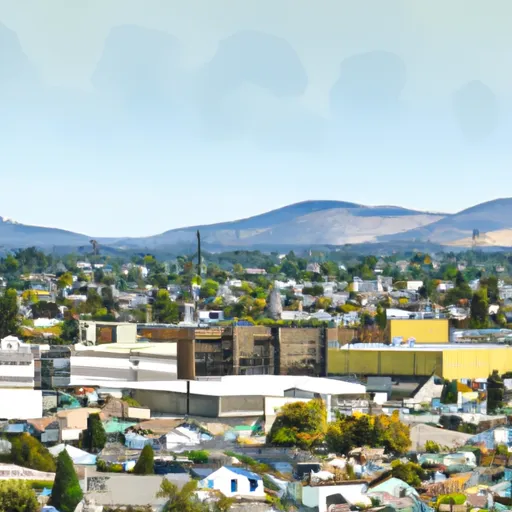-
 Snoflo Premium
Snoflo Premium
Get unlimited access to all our content
With no Ad interruptions! - Start Your Free Trial Login with existing account
Spanish-Flat
Eden Index
Climate
8.3
•
Recreation
4.0
•
Community
4.1
•
Safeguard
5.7/10

Spanish-Flat is a charming town located in Napa County, California. It enjoys a Mediterranean climate, characterized by warm, dry summers and mild, wet winters. Summers are typically sunny and hot, with temperatures averaging in the upper 80s to low 90s°F (30-35°C), while winters are cooler, with temperatures ranging between the mid-40s to low 60s°F (8-15°C). The town experiences minimal rainfall during the summer months but receives a significant amount of precipitation from November to April.
Hydrologically, Spanish-Flat benefits from the nearby Napa River, which flows through the area, providing picturesque views and recreational opportunities. The river is popular for fishing, canoeing, and kayaking, attracting outdoor enthusiasts. Additionally, Spanish-Flat is surrounded by beautiful landscapes with rolling hills and vineyards, making it an ideal spot for hiking, cycling, and exploring nature. There are several parks and trails nearby, offering opportunities for outdoor activities and picnicking.
In conclusion, Spanish-Flat, California offers a pleasant Mediterranean climate, abundant hydrological features like the Napa River, and diverse outdoor recreation options, making it an appealing destination for nature lovers and adventure seekers.
What is the Eden Index?
The Snoflo Eden Index serves as a comprehensive rating system for regions, evaluating their desirability through a holistic assessment of climate health, outdoor recreation opportunities, and natural disaster risk, acknowledging the profound impact of these factors on livability and well-being.
Climate Health Indicator (CHI): 8.3
Spanish-Flat receives approximately
758mm of rain per year,
with humidity levels near 87%
and air temperatures averaging around
16°C.
Spanish-Flat has a plant hardyness factor of
9, meaning
plants and agriculture in this region tend to thrive here all year round.
By considering the ideal temperature range, reliable water supplies, clean air, and stable seasonal rain or snowpacks, the Climate Health Indicator (CHI) underscores the significance of a healthy climate as the foundation for quality living.
A healthy climate is paramount for ensuring a high quality of life and livability in a region, fostering both physical well-being and environmental harmony. This can be characterized by ideal temperatures, reliable access to water supplies, clean air, and consistent seasonal rain or snowpacks.
Weather Forecast
Streamflow Conditions
San Francisco Bay
Area Rivers
San Francisco Bay
Snowpack Depths
San Francisco Bay
Reservoir Storage Capacity
San Francisco Bay
Groundwater Levels
Recreational Opportunity Index (ROI): 4.0
The Recreational Opportunity Index (ROI) recognizes the value of outdoor recreational options, such as parks, hiking trails, camping sites, and fishing spots, while acknowledging that climate plays a pivotal role in ensuring the comfort and consistency of these experiences.
Access to outdoor recreational opportunities, encompassing activities such as parks, hiking, camping, and fishing, is crucial for overall well-being, and the climate plays a pivotal role in enabling and enhancing these experiences, ensuring that individuals can engage in nature-based activities comfortably and consistently.
Camping Areas
| Campground | Campsites | Reservations | Toilets | Showers | Elevation |
|---|---|---|---|---|---|
| China Camp State Park | None | 222 ft | |||
| Lupine Shores - Lake Berryessa - USBR | None | 479 ft | |||
| Chaparral Cove - Lake Berryessa - USBR | None | 433 ft | |||
| Manzanita Canyon - Lake Berryessa - USBR | None | 455 ft | |||
| Foothill Pines - Lake Berryessa - USBR | None | 454 ft | |||
| Napa Valley Expo | None | 15 ft | |||
| Skyline Wilderness County Park | 59 | 184 ft |
Nearby Ski Areas
Catastrophe Safeguard Index (CSI):
The Catastrophe Safeguard Index (CSI) recognizes that natural disaster risk, encompassing floods, fires, hurricanes, and tornadoes, can drastically affect safety and the overall appeal of an area.
The level of natural disaster risk in a region significantly affects safety and the overall livability, with climate change amplifying these risks by potentially increasing the frequency and intensity of events like floods, fires, hurricanes, and tornadoes, thereby posing substantial challenges to community resilience and well-being.
Community Resilience Indicator (CRI): 4.1
The Community Resilience Indicator (CRI) recognizes that education, healthcare, and socioeconomics are crucial to the well-being of a region. The CRI acknowledges the profound impact of these elements on residents' overall quality of life. By evaluating educational resources, healthcare accessibility, and economic inclusivity, the index captures the essential aspects that contribute to a thriving community, fostering resident satisfaction, equity, and social cohesion.

